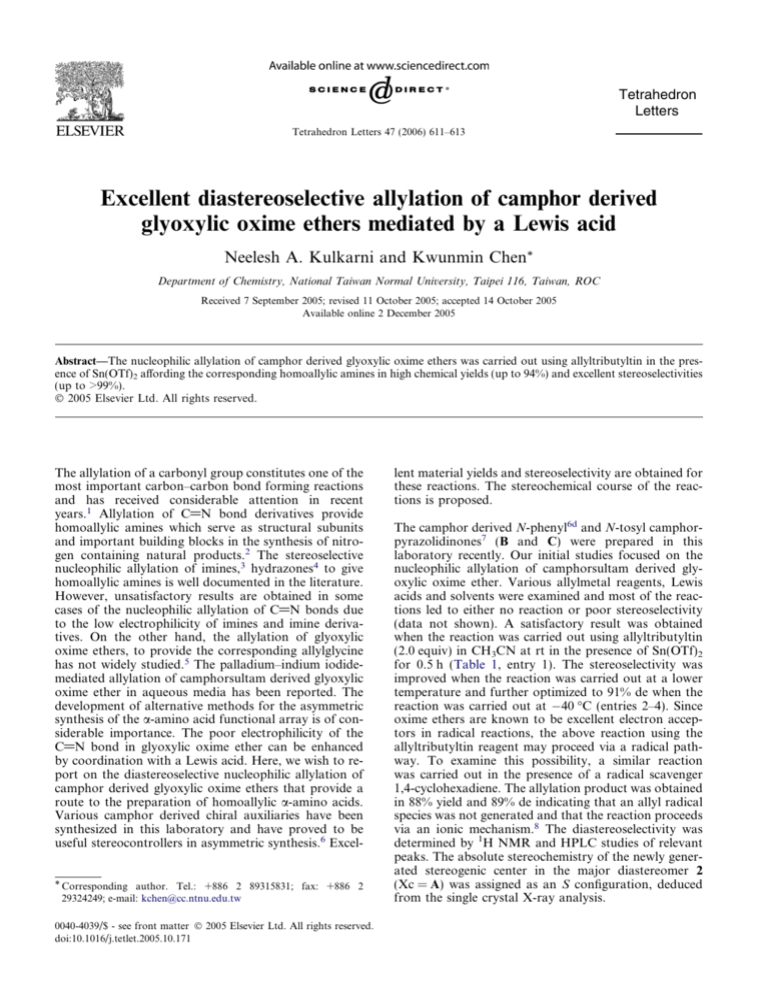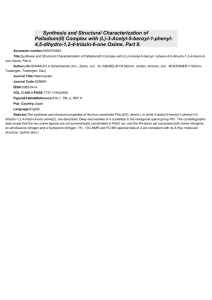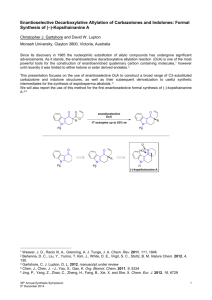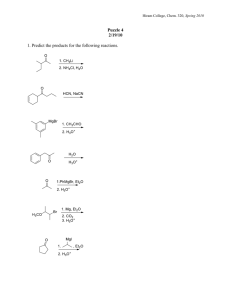
Tetrahedron
Letters
Tetrahedron Letters 47 (2006) 611–613
Excellent diastereoselective allylation of camphor derived
glyoxylic oxime ethers mediated by a Lewis acid
Neelesh A. Kulkarni and Kwunmin Chen*
Department of Chemistry, National Taiwan Normal University, Taipei 116, Taiwan, ROC
Received 7 September 2005; revised 11 October 2005; accepted 14 October 2005
Available online 2 December 2005
Abstract—The nucleophilic allylation of camphor derived glyoxylic oxime ethers was carried out using allyltributyltin in the presence of Sn(OTf)2 affording the corresponding homoallylic amines in high chemical yields (up to 94%) and excellent stereoselectivities
(up to >99%).
Ó 2005 Elsevier Ltd. All rights reserved.
The allylation of a carbonyl group constitutes one of the
most important carbon–carbon bond forming reactions
and has received considerable attention in recent
years.1 Allylation of C@N bond derivatives provide
homoallylic amines which serve as structural subunits
and important building blocks in the synthesis of nitrogen containing natural products.2 The stereoselective
nucleophilic allylation of imines,3 hydrazones4 to give
homoallylic amines is well documented in the literature.
However, unsatisfactory results are obtained in some
cases of the nucleophilic allylation of C@N bonds due
to the low electrophilicity of imines and imine derivatives. On the other hand, the allylation of glyoxylic
oxime ethers, to provide the corresponding allylglycine
has not widely studied.5 The palladium–indium iodidemediated allylation of camphorsultam derived glyoxylic
oxime ether in aqueous media has been reported. The
development of alternative methods for the asymmetric
synthesis of the a-amino acid functional array is of considerable importance. The poor electrophilicity of the
C@N bond in glyoxylic oxime ether can be enhanced
by coordination with a Lewis acid. Here, we wish to report on the diastereoselective nucleophilic allylation of
camphor derived glyoxylic oxime ethers that provide a
route to the preparation of homoallylic a-amino acids.
Various camphor derived chiral auxiliaries have been
synthesized in this laboratory and have proved to be
useful stereocontrollers in asymmetric synthesis.6 Excel* Corresponding author. Tel.: +886 2 89315831; fax: +886 2
29324249; e-mail: kchen@cc.ntnu.edu.tw
0040-4039/$ - see front matter Ó 2005 Elsevier Ltd. All rights reserved.
doi:10.1016/j.tetlet.2005.10.171
lent material yields and stereoselectivity are obtained for
these reactions. The stereochemical course of the reactions is proposed.
The camphor derived N-phenyl6d and N-tosyl camphorpyrazolidinones7 (B and C) were prepared in this
laboratory recently. Our initial studies focused on the
nucleophilic allylation of camphorsultam derived glyoxylic oxime ether. Various allylmetal reagents, Lewis
acids and solvents were examined and most of the reactions led to either no reaction or poor stereoselectivity
(data not shown). A satisfactory result was obtained
when the reaction was carried out using allyltributyltin
(2.0 equiv) in CH3CN at rt in the presence of Sn(OTf)2
for 0.5 h (Table 1, entry 1). The stereoselectivity was
improved when the reaction was carried out at a lower
temperature and further optimized to 91% de when the
reaction was carried out at 40 °C (entries 2–4). Since
oxime ethers are known to be excellent electron acceptors in radical reactions, the above reaction using the
allyltributyltin reagent may proceed via a radical pathway. To examine this possibility, a similar reaction
was carried out in the presence of a radical scavenger
1,4-cyclohexadiene. The allylation product was obtained
in 88% yield and 89% de indicating that an allyl radical
species was not generated and that the reaction proceeds
via an ionic mechanism.8 The diastereoselectivity was
determined by 1H NMR and HPLC studies of relevant
peaks. The absolute stereochemistry of the newly generated stereogenic center in the major diastereomer 2
(Xc = A) was assigned as an S configuration, deduced
from the single crystal X-ray analysis.
612
N. A. Kulkarni, K. Chen / Tetrahedron Letters 47 (2006) 611–613
Table 1. Diastereoselective allylation of glyoxylic oxime ethers using allyltributyltin in the presence of Sn(OTf)2a
NOBn
Xc
b
NOBn
Sn(OTf)2, CH3CN
Allyltributyl tin
Xc
a
O
O
2
1
Me
Me
Me
Me
N
S
O
N
N
O
O
R
A
B = Ph
C = Ts
Entry
Xc
T (°C)
t (h)
Yieldb (%)
1
2
3
4
5e
6
7f
A
A
A
A
A
B
C
rt
0.5
1
1
1
1
1
1
92
90
91
90
88
92
94
0
25
40
40
40
40
dec (%)
56
74
78
91
89
>99
>99
Abs. conf.
S
S
S
Sd
Sd
Sd
Sg
a
Unless otherwise specified, all reactions were carried out in CH3CN at the temperature indicated using 1 (0.13 mmol), allyltributyltin (2.0 equiv) and
Sn(OTf)2 (1 equiv).
b
Isolated yield.
c
Ratios of diastereomers were determined by 1H NMR analysis of relevant peaks and HPLC analyses of crude products.
d
The absolute stereochemistry of the newly generated stereogenic center was deduced by single crystal X-ray analysis.
e
In the presence of 1,4-cyclohexadiene.
f
10 equiv of allyltributyltin was used.
g
Absolute stereochemistry is assigned by analogy.
To examine the scope and applicability of this method,
various oxime ethers bearing a chiral auxiliary were studied. Camphor derived glyoxylic oxime ethers B and C
were subjected to the optimized reaction conditions.
Allylation of N-phenyl and N-tosyl camphorpyrazolidinones derived oxime ethers afforded homoallylic amines
in excellent yields and diastereomeric excess (entries 6
and 7). The allylation of oxime ethers derived from other
auxiliaries (( )-4-phenyl-oxazolidin-2-one) and some
ester linked chiral auxiliaries (10,10-diphenyl-2,10camphordiol,6e (+)-menthol and ( )-N-methylephedrine) led to poor stereoselectivities.
A single crystal X-ray analysis of 1 (Xc = A) indicates
that N–(CO) is oriented anti to the sulfonyl group to
minimize dipole–dipole interactions and the carbonyl
and imino groups exist in a s-cis conformation. On the
other hand, for N-phenyl camphorpyrazolidinones
(Xc = B), the carbonyl and imino functionalities are
arranged in a s-trans conformation with the amide
carbonyl group oriented toward the phenyl group as
indicated by single crystal X-ray analysis. By analogy to
the N-phenyl camphorpyrazolidinone derived a-keto
amides,6b the carbonyl and imino groups are oriented
in a s-trans arrangement in 1 (Xc = C) with the amide
group facing away from the tosyl functionality. The
exact mechanistic explanation for the reaction remains
unclear at this moment. To rationalize the stereoinduction bias of the reaction, a series of 13C NMR and FTIR
spectra were obtained. A comparison of the 13C NMR
spectrum of the pure substrate with that of a mixture
of equal amounts of a-imino amides 1 and Sn(OTf)2
was obtained. The chemical shift in carbons a and b of
the pure substrate and the chemical shift difference
(shown in parenthesis after complexation with
Sn(OTf)2) are tabulated in Table 2. The 13C NMR spectral analysis indicates that Sn(OTf)2 chelates strongly
with oxime nitrogen and adjacent carbonyl when auxiliary B is used.
Further, significant S@O group stretching bands difference were observed when a-imino amide 1 (Xc = A
and C) was complexed with Sn(OTf)2 by FTIR spectroscopy. The IR stretching band corresponding to an S@O
group of 1260.5 and 1175.1 cm 1 were observed for auxiliaried A and C derived substrates. A new stretching
band at 1245.9 and 1164.5 cm 1 was developed for each
complex, respectively. Based on these findings, the high
degree of stereoselectivity can be rationalized by the chelation of the Lewis acid with 1 as shown in Figure 1. For
the two sulfonyl functionalities containing auxiliaries
Table 2. The 13C NMR chemical shift comparison of pure substrates 1
and after complexation with Sn(OTf)2
Entry
1 (Xc =)
Carbon a (Dd)
Carbon b (Dd)
1
2
3
A
B
C
160.37 (+1.04)
158.91 ( 2.84)
161.78 (+0.10)
143.25 ( 0.54)
144.23 ( 2.24)
143.71 ( 0.51)
N. A. Kulkarni, K. Chen / Tetrahedron Letters 47 (2006) 611–613
Me
Me
O
NOBn
N
S
O
O
Me
H
Sn OTf
SnBu3
Me
H
N
N
O
OTf
S
Tol
NOBn
O
Sn
O
Me
O
N
SnBu3
OTf
Me
Ph
H
N
H
O
References and notes
OTf
NOBn
N
University which is gratefully acknowledged. Our
gratitude is expressed to the Academic Paper Editing
Clinic, NTNU.
Me
Me
O
O
N
Ph
613
NOBn
O
Sn
OTf
OTf
SnBu3
Figure 1. Proposed mechanism of the asymmetric allylatin.
(Xc = A and C), the Sn atom coordinates with the two
sulfonyl oxygen atoms. On the other hand, for 1
(Xc = B), the Lewis acid coordinates to the carbonyl
and a-oxime ether groups to form a transition state
species with a five-membered ring. The allyl group then
attacks from the si face to afford the desired product.
In summary, three camphor derived glyoxylic oxime
ethers were prepared and subjected to the allylation condition using allyltributyltin to give the homoallylic
amines in high chemical yields and excellent stereoselectivities in the presence of Sn(OTf)2. Further synthetic
applications of camphor derived glyoxylic oxime ethers
are under progress.
Acknowledgements
We thank the National Science Council of the Republic
of China (NSC 94-2113-M-003-003) and the National
Taiwan Normal University (ORD 93-C), for financial
support of this work. The X-ray crystal data were
collected and processed by National Taiwan Normal
1. For a recent review, see: Denmark, S. E.; Fu, J. Chem. Rev.
2003, 103, 2763, and references cited therein.
2. (a) Jain, R. P.; Williams, R. M. J. Org. Chem. 2002, 67,
6361; (b) Fabio, R. D.; Alvaro, G.; Bertani, B.; Donati, D.;
Giacobbe, S.; Marchioro, C.; Palma, C.; Lynn, S. M. J.
Org. Chem. 2002, 67, 7319.
3. For recent reviews, see: (a) Puentes, C. O.; Kouznetsov, V.
J. Heterocycl. Chem. 2002, 39, 595; (b) Denmark, S. E.;
Almstead, N. G. In Modern Carbonyl Chemistry; Otera, J.,
Ed.; Wiley-VHC: Weinheim, 2000, Chapter 10 and references cited therein; For some examples, see: (c) Shimizu,
M.; Kimura, M.; Watanabe, T.; Tamaru, Y. Org. Lett.
2005, 7, 637; (d) Solin, N.; Wallner, O. A.; Szabo, K. J. Org.
Lett. 2005, 7, 689; (e) Fernandes, R. A.; Yamamoto, Y. J.
Org. Chem. 2004, 69, 735; (f) Chen, Y.; Yekta, S.; Yudin, A.
K. Chem. Rev. 2003, 103, 3155; (g) Fernandes, R. A.;
Stimac, A.; Yamamoto, Y. J. Am. Chem. Soc. 2003, 125,
14133; (h) Kobayashi, S.; Ishitani, H. Chem. Rev. 1999, 99,
1069; (i) Hanessian, S.; Lu, P.-P.; Sanceau, J. Y.; Chemla,
P.; Gohda, K.; Fonne-Pfister, R.; Prade, L.; Cowan-Jacob,
S. W. Angew. Chem., Int. Ed. 1999, 38, 3160.
4. (a) Cook, G. R.; Maity, B. C.; Kargbo, R. Org. Lett. 2004,
6, 1741; (b) Berger, R.; Rabbat, P. M.; Leighton, J. L. J.
Am. Chem. Soc. 2003, 125, 9596; (c) Kobayashi, S.; Ogawa,
C.; Konishi, H.; Sugiura, M. J. Am. Chem. Soc. 2003, 125,
6610; (d) Hamada, T.; Manabe, K.; Kobayashi, S. Angew.
Chem., Int. Ed. 2003, 42, 3927.
5. (a) Miyabe, H.; Yamaoka, Y.; Naito, T.; Takemoto, Y. J.
Org. Chem. 2004, 69, 1415; (b) Miyabe, H.; Yamaoka, Y.;
Naito, T.; Takemoto, Y. J. Org. Chem. 2003, 68, 6745; (c)
Miyabe, H.; Nishimura, A.; Ueda, M.; Naito, T. Chem.
Commun. 2002, 14, 1454.
6. (a) Pan, J.-F.; Venkatesham, U.; Chen, K. Tetrahedron
Lett. 2004, 45, 9345; (b) Wang, S.-G.; Tsai, H. R.; Chen,
K. Tetrahedron Lett. 2004, 45, 6183; (c) Pan, J.-F.; Chen, K.
Tetrahedron Lett. 2004, 45, 2541; (d) Yang, K.-S.; Chen, K.
Org. Lett. 2000, 2, 729; (e) Chu, Y.-Y.; Yu, C.-S.; Chen,
C.-J.; Yang, K.-S.; Lain, J.-C.; Lin, C.-H.; Chen, K. J. Org.
Chem. 1999, 63, 6993.
7. Chen, J.-H.; Venkatesham, U.; Lee, L.-C.; Chen, K.
Tetrahedron, 2005, in press.
8. Niwa, Y.; Shimizu, M. J. Am. Chem. Soc. 2003, 125, 3720.







